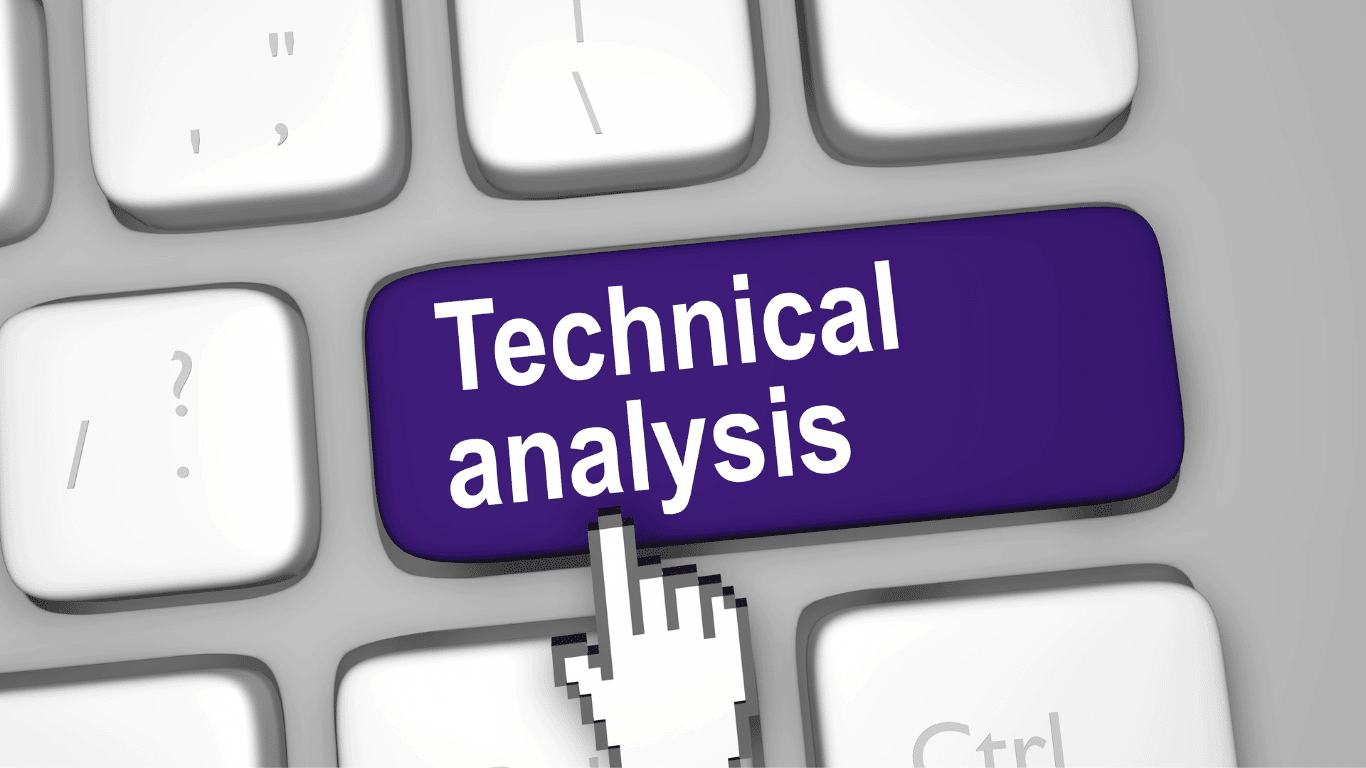- What is technical analysis?
- Advantages of Technical Analysis
- Disadvantages of Technical Analysis
- What are the benefits of using technical analysis to identify market trends, patterns, and signals?
- What are the main types and categories of technical indicators and what do they measure?
- How can traders combine technical analysis with other methods of analysis, such as fundamental analysis, chart patterns, support and resistance levels, etc.?
Investing in the stock market requires careful consideration and analysis of various factors. A popular approach of technical analysis used by investors is reviewing past price and volume data to identify repeated patterns that may be used to anticipate future price movements.
However, like any investment strategy, there are advantages and disadvantages of technical analysis that investors should know. In this guide, we will go through the pros and cons of technical analysis and its key differences from fundamental analysis.
Investors use various methods and strategies to make informed decisions in the stock market. Technical analysis has gained popularity as a method that reviews previous trends in the market based on price and value. However, it is essential to understand the advantages and disadvantages of technical analysis before incorporating it into your investment strategy.
What is technical analysis?
The technical analysis assesses securities that involve studying market behaviour data such as historical prices and volume. Unlike fundamental analysis, which considers a stock’s intrinsic value based on economic factors, technical analysis focuses on the price and volume data reflected in charts. Technical analysts aim to predict future price movements by identifying patterns in these charts.

Advantages of Technical Analysis
High Flexibility
One main advantage of technical analysis is its high flexibility nature. It can be applied to various financial markets, including stocks, international money markets, interest rates, gold, Bitcoin, forex, and cryptocurrencies. Unlike fundamental analysis, which may not easily translate across different markets, technical analysis can be adjusted and tailored in different timeframes, whether short-term or long-term.
Time Efficiency

Technical analysis is known for its time efficiency. When time is limited, or opportunity costs are involved, technical analysis allows investors to focus on the net effect of price movements rather than delving into the root causes. This enables quicker analysis and decision-making, acknowledging that time waits for no one.
Early Price Movements
Price movements sometimes occur before fundamental analysts discover the underlying causes. Market trends are influenced by numerous rational and irrational factors, creating momentum phases. Technical analysis helps investors identify these trends early, providing valuable insights for investment decision-making.
Psychology at the Heart of Investing
A significant advantage of technical analysis is its ability to tap into herd psychology. Investors can better understand the market’s collective sentiment towards a company or industry by interpreting charts. Bullish and bearish trends reflect the optimism or pessimism of investors, creating profit opportunities. Technical analysis helps identify levels of support and resistance, which are determined by market memory and herd perception.
Disadvantages of Technical Analysis
Past and Historical Data

One of the main drawbacks of technical analysis is its reliance on past and historical data. It does not consider unexpected future events that may impact stock prices. While patterns and trends can provide insights, they do not guarantee future outcomes.
Analyst Bias
Like fundamental analysis, technical analysis is subjective and can be influenced by analyst bias. Personal opinions and biases can be reflected in the interpretation of charts and indicators, potentially leading to incorrect conclusions.
No Explanation about the Tools Used
Technical analysis employs various tools and indicators, but many analysts struggle to explain their use convincingly. Understanding the rationale behind these tools can be challenging, leading to doubts about their effectiveness.
Limited Use of Technical Analysis
Empirical evidence supporting the random walk hypothesis casts doubt on the usefulness of technical analysis. In an efficient and well-ordered market, technical analysis may have limited value. However, technical analysis can still provide valuable insights into imperfect and irrational markets.
What are the benefits of using technical analysis to identify market trends, patterns, and signals?
Some of the benefits provided when using technical analysis to identify trends, patterns, and signals in the market are:
- Identifying trading opportunities: Technical analysis can help a trader spot potential entry and exit points based on the data and trading volume on the market. Many technical analysis indicators can be used to find signals that reveal a price trend’s direction, strength, and duration.
- Managing risk: Technical analysis may also assist you with risk management by establishing suitable stop-loss levels, trailing stops, and profit targets based on a security’s support and resistance levels, trend lines, and chart patterns. Technical analysis may also calculate a trade’s volatility and risk-reward ratio.
- Making more informed decisions: By giving a data-driven approach to market analysis, technical analysis may assist you in making better-educated judgments. Technical analysis may assess and validate trading hypotheses and methods based on historical data and statistics. Technical analysis may also supplement other kinds of study, such as fundamental analysis, to provide a more complete picture of a security’s worth and potential.
- Improving your trading strategy: Technical analysis may assist you in improving your trading strategy by fine-tuning your parameters, indicators, and time frames based on your trading style and goals. Depending on different market scenarios and conditions, technical analysis may also be used to backtest and enhance your trading method. Technical analysis can also help track your progress and assess your trading outcomes.
What are the main types and categories of technical indicators and what do they measure?
Technical indicators are indications generated by the price, volume, and open interest of a particular asset or contract that technical analysts employ. They assess many elements of market activity and assist traders in making better-informed decisions in the market.
The four main categories of technical indicators are explained below.
- Trend indicators: Trend indicators are most often used to follow the path of the market trend, usually the direction in which the price is headed. These indicators are also able to show the strength-duration of a tre. Some examples of trend indicators include parabolic SAR, MACD and moving averages.
- Momentum indicators: Momentum indicators measure the speed, force, and power of a price movement. These indicators can decipher trend continuation or reversal. They also can show whether an asset is overbought or oversold. Some examples of this indicator include RSI, CCI1 and stochastic oscillators.
- Volatility indicators assess the degree of variance or volatility in price movement, which might reflect market uncertainty or risk. Volatility indicators can also reveal times of consolidation or growth, which are possible market breakout situations. Common volatility indicators include Bollinger bands, average true range, and standard deviation.
- Volume indicators determine the level of trading activity or interest in an asset or contract, which might reflect the strength or weakness of a price movement. Volume indicators can also reflect price and volume divergence or convergence, which can be used to predict trend shifts. Volume indicators include the Chaikin oscillator, the OBV, and the volume rate of change
How can traders combine technical analysis with other methods of analysis, such as fundamental analysis, chart patterns, support and resistance levels, etc.?
Traders can combine technical analysis with various other analysis methods, such as fundamental analysis, chart patterns, support and resistance levels, etc.; using these methods helps individuals get a more comprehensive view of the market and the security they are trading. Different analysis methods provide additional insights and perspectives and confirm or contradict each other. Traders can boost their trust and precision in trading choices by combining strategies.
Traders can combine technical analysis with other kinds of analysis in the following ways:
- Range-bound trading and fundamental analysis: Range-bound trading is a technical approach that entails purchasing at a price channel’s lower trendline support and selling at the higher trendline resistance. Traders may use fundamental analysis to determine the possible influence of news events or economic data on an asset’s price movement and volatility. Traders, for example, can avoid opening trades around important news releases that could trigger the range-bound market, or they can exploit them to profit from overreactions to the news.
- Breakout trading with fundamental analysis: Breakout trading is a technical approach that includes profiting when prices go outside a specified trading range, which news events can often cause. Traders may use fundamental analysis to detect probable catalysts, the direction of the price breakout, and the strength and longevity of the new trend. Traders can, for example, utilize positive earnings or economic data to forecast a bullish breakout or negative earnings or economic data to forecast a bearish breakout.
Technical Analysis vs Fundamental Analysis:
While technical analysis focuses on price and volume, fundamental analysis considers a stock’s intrinsic value based on economic factors, financial statements, and industry analysis. Fundamental analysis is often used to determine whether a stock is undervalued or overvalued, while technical analysis is more concerned with identifying trends and patterns in the market.
Conclusion – Advantages and Disadvantages of Technical Analysis:
In conclusion, technical analysis offers several advantages for investors, including high flexibility, time efficiency, and the ability to identify early price movements. However, it also has limitations, such as reliance on past data and the potential for analyst bias. By integrating technical and fundamental analysis, investors may acquire a more comprehensive view of the market and make more informed investing decisions.
Technical analysis is a market analysis technique that can assist traders and investors in identifying trends, patterns, and indications in the price movement of an asset. Traders and investors can evaluate numerous elements of market activity and make better-educated decisions by employing several technical indicators, such as trend, momentum, volatility, and volume indicators. Technical analysis, on the other hand, is not a perfect science, and it has limitations and challenges. As a result, it is critical to combine technical analysis with different types of analysis, such as fundamental analysis, and to test and validate the conclusions and indications before applying them to real-world trading scenarios.

